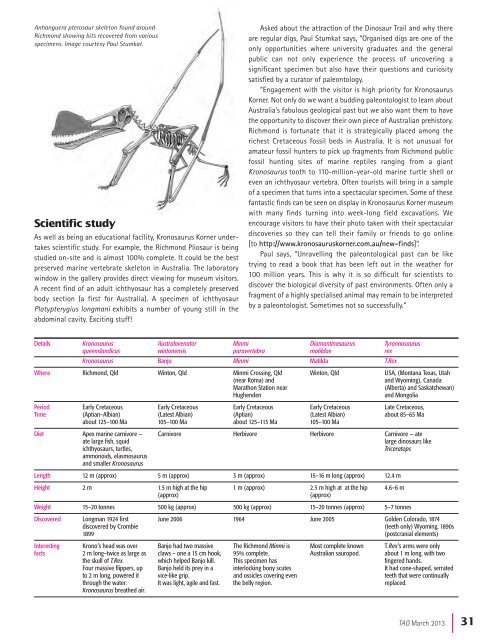TAG 166 - Geological Society of Australia
TAG 166 - Geological Society of Australia
TAG 166 - Geological Society of Australia
You also want an ePaper? Increase the reach of your titles
YUMPU automatically turns print PDFs into web optimized ePapers that Google loves.
Anhanguera pterosaur skeleton found aroundRichmond showing bits recovered from variousspecimens. Image courtesy Paul Stumkat.Scientific studyAs well as being an educational facility, Kronosaurus Korner undertakesscientific study. For example, the Richmond Pliosaur is beingstudied on-site and is almost 100% complete. It could be the bestpreserved marine vertebrate skeleton in <strong>Australia</strong>. The laboratorywindow in the gallery provides direct viewing for museum visitors.A recent find <strong>of</strong> an adult ichthyosaur has a completely preservedbody section (a first for <strong>Australia</strong>). A specimen <strong>of</strong> ichthyosaurPlatypterygius longmani exhibits a number <strong>of</strong> young still in theabdominal cavity. Exciting stuff!Asked about the attraction <strong>of</strong> the Dinosaur Trail and why thereare regular digs, Paul Stumkat says, “Organised digs are one <strong>of</strong> theonly opportunities where university graduates and the generalpublic can not only experience the process <strong>of</strong> uncovering asignificant specimen but also have their questions and curiositysatisfied by a curator <strong>of</strong> paleontology.“Engagement with the visitor is high priority for KronosaurusKorner. Not only do we want a budding paleontologist to learn about<strong>Australia</strong>’s fabulous geological past but we also want them to havethe opportunity to discover their own piece <strong>of</strong> <strong>Australia</strong>n prehistory.Richmond is fortunate that it is strategically placed among therichest Cretaceous fossil beds in <strong>Australia</strong>. It is not unusual foramateur fossil hunters to pick up fragments from Richmond publicfossil hunting sites <strong>of</strong> marine reptiles ranging from a giantKronosaurus tooth to 110-million-year-old marine turtle shell oreven an ichthyosaur vertebra. Often tourists will bring in a sample<strong>of</strong> a specimen that turns into a spectacular specimen. Some <strong>of</strong> thesefantastic finds can be seen on display in Kronosaurus Korner museumwith many finds turning into week-long field excavations. Weencourage visitors to have their photo taken with their spectaculardiscoveries so they can tell their family or friends to go online[to http://www.kronosauruskorner.com.au/new-finds]”.Paul says, “Unravelling the paleontological past can be liketrying to read a book that has been left out in the weather for100 million years. This is why it is so difficult for scientists todiscover the biological diversity <strong>of</strong> past environments. Often only afragment <strong>of</strong> a highly specialised animal may remain to be interpretedby a paleontologist. Sometimes not so successfully.”Details Kronosaurus Australovenator Minmi Diamantinasaurus Tyrannosaurusqueenslandicus wintonensis paravertebra matildae rexKronosaurus Banjo Minmi Matilda T.RexWhere Richmond, Qld Winton, Qld Minmi Crossing, Qld Winton, Qld USA, (Montana Texas, Utah(near Roma) andand Wyoming), CanadaMarathon Station near(Alberta) and Saskatchewan)Hughendenand MongoliaPeriod Early Cretaceous Early Cretaceous Early Cretaceous Early Cretaceous Late Cretaceous,Time (Aptian–Albian) (Latest Albian) (Aptian) (Latest Albian) about 85–65 Maabout 125–100 Ma 105–100 Ma about 125–113 Ma 105–100 MaDiet Apex marine carnivore — Carnivore Herbivore Herbivore Carnivore — ateate large fish, squidlarge dinosaurs likeichthyosaurs, turtles,Triceratopsammonoids, elasmosaurusand smaller KronosaurusLength 12 m (approx) 5 m (approx) 3 m (approx) 15–16 m long (approx) 12.4 mHeight 2 m 1.5 m high at the hip 1 m (approx) 2.5 m high at at the hip 4.6–6 m(approx)(approx)Weight 15–20 tonnes 500 kg (approx) 500 kg (approx) 15–20 tonnes (approx) 5–7 tonnesDiscovered Longman 1924 first June 2006 1964 June 2005 Golden Colorado, 1874discovered by Crombie(teeth only) Wyoming, 1890s1899 (postcranial elements)Interesting Krono’s head was over Banjo had two massive The Richmond Minmi is Most complete known T.Rex’s arms were onlyfacts 2 m long–twice as large as claws – one a 15 cm hook, 95% complete. <strong>Australia</strong>n sauropod. about 1 m long, with twothe skull <strong>of</strong> T.Rex. which helped Banjo kill. This specimen has fingered hands.Four massive flippers, up Banjo held its prey in a interlocking bony scutes It had cone-shaped, serratedto 2 m long, powered it vice-like grip. and ossicles covering even teeth that were continuallythrough the water. It was light, agile and fast. the belly region. replaced.Kronosaurus breathed air.<strong>TAG</strong> March 2013| 31
















